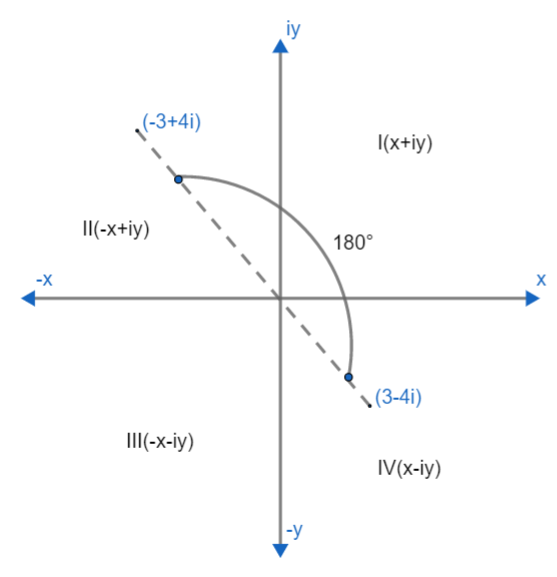
The vector 3-4i is turned anticlockwise through an angle of ${{180}^{\circ }}$ and stretched 2.5 times. The complex number corresponding to the newly obtained vector is ..
\[\begin{align}
& A.\dfrac{-15}{2}+10i \\
& B.\dfrac{15}{2}+10i \\
& C.\dfrac{-15}{2}-10i \\
& D.\dfrac{15}{2}-10i \\
\end{align}\]
Answer
557.4k+ views
Hint: For solving this question, we first need to understand the signs in the complex plane. Since every complex plane is of the form x+iy. So a complex plane is the same as an argand plane where x is x and y is y axis. First we will find the quadrant in which the current vector is lying. Then we will find the quadrant if the vector is rotated through an angle ${{180}^{\circ }}$. Using the quadrant, we will change the sign of the vector and at last we will multiply obtained vector by 2.5 to get the required vector.
Complete step-by-step answer:
Let us understand the complex plane first. In the complex plane the horizontal axis is the x axis and vertical axis is y axis. It looks like this:

Complex numbers of the form x+iy lie in I quadrant, -x+iy lie in II quadrant, -x-iy lies in III quadrant and x-iy lies in IV quadrant.
Here we are given complex numbers as 3-4i. It is of the form x-iy. So it lies in the IV quadrant. If we turn the vector anticlockwise to ${{180}^{\circ }}$ our new vector will lie in II quadrant where vectors are of form -x+iy. So our vector becomes -3+4i.
Now, we have to stretch it 2.5 times, so our new vector becomes 2.5 times the original vector. So required complex number will be,
\[\begin{align}
& \Rightarrow 2.5\left( -3+4i \right) \\
& \Rightarrow \left( -2.5\times 3 \right)+\left( 2.5\times 4 \right)i \\
& \Rightarrow \left( \dfrac{-25\times 3}{10} \right)+\left( \dfrac{25\times 4}{10} \right)i \\
& \Rightarrow \dfrac{-15}{2}+10i \\
\end{align}\]
Hence, $\dfrac{-15}{2}+10i$ is our required vector.
So, the correct answer is “Option A”.
Note: Here students can make mistakes in positive and negative signs in quadrant. While changing quadrants, make sure that numbers remain the same and only sign changes. While selecting a vector, make sure 2.5 is multiplied with both -3 and 4. Complex plane is just like argand plane.
Complete step-by-step answer:
Let us understand the complex plane first. In the complex plane the horizontal axis is the x axis and vertical axis is y axis. It looks like this:

Complex numbers of the form x+iy lie in I quadrant, -x+iy lie in II quadrant, -x-iy lies in III quadrant and x-iy lies in IV quadrant.
Here we are given complex numbers as 3-4i. It is of the form x-iy. So it lies in the IV quadrant. If we turn the vector anticlockwise to ${{180}^{\circ }}$ our new vector will lie in II quadrant where vectors are of form -x+iy. So our vector becomes -3+4i.
Now, we have to stretch it 2.5 times, so our new vector becomes 2.5 times the original vector. So required complex number will be,
\[\begin{align}
& \Rightarrow 2.5\left( -3+4i \right) \\
& \Rightarrow \left( -2.5\times 3 \right)+\left( 2.5\times 4 \right)i \\
& \Rightarrow \left( \dfrac{-25\times 3}{10} \right)+\left( \dfrac{25\times 4}{10} \right)i \\
& \Rightarrow \dfrac{-15}{2}+10i \\
\end{align}\]
Hence, $\dfrac{-15}{2}+10i$ is our required vector.
So, the correct answer is “Option A”.
Note: Here students can make mistakes in positive and negative signs in quadrant. While changing quadrants, make sure that numbers remain the same and only sign changes. While selecting a vector, make sure 2.5 is multiplied with both -3 and 4. Complex plane is just like argand plane.
Recently Updated Pages
A man running at a speed 5 ms is viewed in the side class 12 physics CBSE

The number of solutions in x in 02pi for which sqrt class 12 maths CBSE

State and explain Hardy Weinbergs Principle class 12 biology CBSE

Write any two methods of preparation of phenol Give class 12 chemistry CBSE

Which of the following statements is wrong a Amnion class 12 biology CBSE

Differentiate between action potential and resting class 12 biology CBSE

Trending doubts
What are the major means of transport Explain each class 12 social science CBSE

Which are the Top 10 Largest Countries of the World?

Draw a labelled sketch of the human eye class 12 physics CBSE

How much time does it take to bleed after eating p class 12 biology CBSE

Explain sex determination in humans with line diag class 12 biology CBSE

Explain sex determination in humans with the help of class 12 biology CBSE




